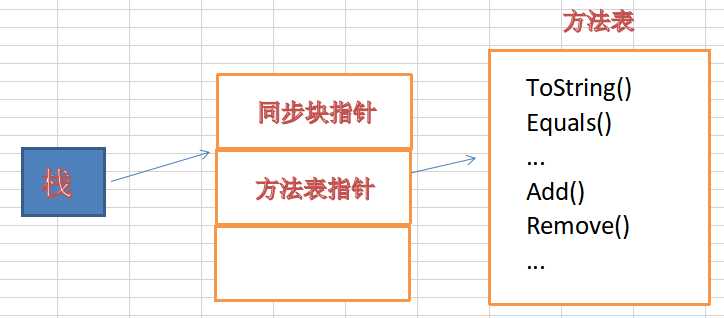标签:float lis page 方法表 capacity jpg 程序员 tco ldl
现代程序员写代码没有人敢说自己没用过泛型,这个泛型模板T可以被任何你想要的类型替代,确实很魔法很神奇,很多人也习以为常了,但就是这么有趣的泛型T底层到底是怎么帮你实现的,不知道有多少人清楚底层玩法,这篇我就试着来分享一下,不一定全对哈。。。
现在的netcore 3.1和最新的.netframework8早已经没有当初那个被人诟病的ArrayList了,但很巧这玩意不得不说,因为它决定了C#团队痛改前非,抛弃过往重新上路,上一段ArrayList案例代码。
public class ArrayList
{
private object[] items;
private int index = 0;
public ArrayList()
{
items = new object[10];
}
public void Add(object item)
{
items[index++] = item;
}
}
上面这段代码,为了保证在Add中可以塞入各种类型 eg: int,double,class, 就想到了一个绝招用祖宗类object接收,这就引入了两大问题,装箱拆箱和类型安全。
这个很好理解,因为你使用了祖宗类,所以当你 Add 的时候塞入的是值类型的话,自然就有装箱操作,比如下面代码:
ArrayList arrayList = new ArrayList();
arrayList.Add(3);
这个问题我准备用windbg看一下,相信大家知道一个int类型占用4个字节,那装箱到堆上是几个字节呢,好奇吧??。
原始代码和IL代码如下:
public static void Main(string[] args)
{
var num = 10;
var obj = (object)num;
Console.Read();
}
IL_0000: nop
IL_0001: ldc.i4.s 10
IL_0003: stloc.0
IL_0004: ldloc.0
IL_0005: box [mscorlib]System.Int32
IL_000a: stloc.1
IL_000b: call int32 [mscorlib]System.Console::Read()
IL_0010: pop
IL_0011: ret
可以清楚的看到IL_0005 中有一个box指令,装箱没有问题,然后抓一下dump文件。
~0s -> !clrstack -l -> !do 0x0000018300002d48
0:000> ~0s
ntdll!ZwReadFile+0x14:
00007ff9`fc7baa64 c3 ret
0:000> !clrstack -l
OS Thread Id: 0xfc (0)
Child SP IP Call Site
0000002c397fedf0 00007ff985c808f3 ConsoleApp2.Program.Main(System.String[]) [C:\dream\Csharp\ConsoleApp1\ConsoleApp2\Program.cs @ 28]
LOCALS:
0x0000002c397fee2c = 0x000000000000000a
0x0000002c397fee20 = 0x0000018300002d48
0000002c397ff038 00007ff9e51b6c93 [GCFrame: 0000002c397ff038]
0:000> !do 0x0000018300002d48
Name: System.Int32
MethodTable: 00007ff9e33285a0
EEClass: 00007ff9e34958a8
Size: 24(0x18) bytes
File: C:\WINDOWS\Microsoft.Net\assembly\GAC_64\mscorlib\v4.0_4.0.0.0__b77a5c561934e089\mscorlib.dll
Fields:
MT Field Offset Type VT Attr Value Name
00007ff9e33285a0 40005a0 8 System.Int32 1 instance 10 m_value
倒数第5行 Size: 24(0x18) bytes, 可以清楚的看到是24字节。 为什么是24个字节,8(同步块指针) + 8(方法表指针) + 4(对象大小)=20,但因为是x64位,内存是按8对齐,也就是要按8的倍数计算,所以占用是 8+8+8 =24 字节,原来只有4字节的大小因为装箱已被爆到24字节,如果是10000个值类型的装箱那空间占用是不是挺可怕的?
很简单,因为是祖宗类型object,所以无法避免程序员使用乱七八糟的类型,当然这可能是无意的,但是编译器确无法规避,代码如下:
ArrayList arrayList = new ArrayList();
arrayList.Add(3);
arrayList.Add(new Action<int>((num) => { }));
arrayList.Add(new object());
面对这两大尴尬的问题,C#团队决定重新设计一个类型,实现一定终身,这就有了泛型。
首先可以明确的说,泛型就是为了解决这两个问题而生的,你可以在底层提供的List<T>中使用List<int>,List<double>。。。等等你看得上的类型,而这种技术的底层实现原理才是本篇关注的重点。
public static void Main(string[] args)
{
List<double> list1 = new List<double>();
List<string> list3 = new List<string>();
...
}
这个问题的探索其实就是 List<T> -> List<int>在何处实现了 T -> int 的替换,反观java,它的泛型实现其实在底层还是用object来替换的,C#肯定不是这么做的,不然也没这篇文章啦,要知道在哪个阶段被替换了,你起码要知道C#代码编译的几个阶段,为了理解方便,我画一张图吧。

流程大家也看到了,要么在MSIL中被替换,要么在JIT编译中被替换。。。
public static void Main(string[] args)
{
List<double> list1 = new List<double>();
List<int> list2 = new List<int>();
List<string> list3 = new List<string>();
List<int[]> list4 = new List<int[]>();
Console.ReadLine();
}
因为第一阶段是MSIL代码,所以用ILSpy看一下中间代码即可。
IL_0000: nop
IL_0001: newobj instance void class [mscorlib]System.Collections.Generic.List`1<float64>::.ctor()
IL_0006: stloc.0
IL_0007: newobj instance void class [mscorlib]System.Collections.Generic.List`1<int32>::.ctor()
IL_000c: stloc.1
IL_000d: newobj instance void class [mscorlib]System.Collections.Generic.List`1<string>::.ctor()
IL_0012: stloc.2
IL_0013: newobj instance void class [mscorlib]System.Collections.Generic.List`1<int32[]>::.ctor()
IL_0018: stloc.3
IL_0019: call string [mscorlib]System.Console::ReadLine()
IL_001e: pop
IL_001f: ret
.class public auto ansi serializable beforefieldinit System.Collections.Generic.List`1<T>
extends System.Object
implements class System.Collections.Generic.IList`1<!T>,
class System.Collections.Generic.ICollection`1<!T>,
class System.Collections.Generic.IEnumerable`1<!T>,
System.Collections.IEnumerable,
System.Collections.IList,
System.Collections.ICollection,
class System.Collections.Generic.IReadOnlyList`1<!T>,
class System.Collections.Generic.IReadOnlyCollection`1<!T>
从上面的IL代码中可以看到,最终的类定义还是 System.Collections.Generic.List1\<T>,说明在中间代码阶段还是没有实现 T -> int 的替换。
想看到JIT编译后的代码,这个说难也不难,其实每个对象头上都有一个方法表指针,而这个指针指向的就是方法表,方法表中有该类型的所有最终生成方法,如果不好理解,我就画个图。

!dumpheap -stat 寻找托管堆上的四个List对象。
0:000> !dumpheap -stat
Statistics:
MT Count TotalSize Class Name
00007ff9e3314320 1 32 Microsoft.Win32.SafeHandles.SafeViewOfFileHandle
00007ff9e339b4b8 1 40 System.Collections.Generic.List`1[[System.Double, mscorlib]]
00007ff9e333a068 1 40 System.Collections.Generic.List`1[[System.Int32, mscorlib]]
00007ff9e3330d58 1 40 System.Collections.Generic.List`1[[System.String, mscorlib]]
00007ff9e3314a58 1 40 System.IO.Stream+NullStream
00007ff9e3314510 1 40 Microsoft.Win32.Win32Native+InputRecord
00007ff9e3314218 1 40 System.Text.InternalEncoderBestFitFallback
00007ff985b442c0 1 40 System.Collections.Generic.List`1[[System.Int32[], mscorlib]]
00007ff9e338fd28 1 48 System.Text.DBCSCodePageEncoding+DBCSDecoder
00007ff9e3325ef0 1 48 System.SharedStatics
可以看到从托管堆中找到了4个list对象,现在我就挑一个最简单的 System.Collections.Generic.List1[[System.Int32, mscorlib]] ,前面的 00007ff9e333a068 就是方法表地址。
!dumpmt -md 00007ff9e333a068
0:000> !dumpmt -md 00007ff9e333a068
EEClass: 00007ff9e349b008
Module: 00007ff9e3301000
Name: System.Collections.Generic.List`1[[System.Int32, mscorlib]]
mdToken: 00000000020004af
File: C:\WINDOWS\Microsoft.Net\assembly\GAC_64\mscorlib\v4.0_4.0.0.0__b77a5c561934e089\mscorlib.dll
BaseSize: 0x28
ComponentSize: 0x0
Slots in VTable: 77
Number of IFaces in IFaceMap: 8
--------------------------------------
MethodDesc Table
Entry MethodDesc JIT Name
00007ff9e3882450 00007ff9e3308de8 PreJIT System.Object.ToString()
00007ff9e389cc60 00007ff9e34cb9b0 PreJIT System.Object.Equals(System.Object)
00007ff9e3882090 00007ff9e34cb9d8 PreJIT System.Object.GetHashCode()
00007ff9e387f420 00007ff9e34cb9e0 PreJIT System.Object.Finalize()
00007ff9e38a3650 00007ff9e34dc6e8 PreJIT System.Collections.Generic.List`1[[System.Int32, mscorlib]].Add(Int32)
00007ff9e4202dc0 00007ff9e34dc7f8 PreJIT System.Collections.Generic.List`1[[System.Int32, mscorlib]].Insert(Int32, Int32)
上面方法表中的方法过多,我做了一下删减,可以清楚的看到,此时Add方法已经接受(Int32)类型的数据了,说明在JIT编译之后,终于实现了 T -> int 的替换,然后再把 List<double> 打出来看一下。
0:000> !dumpmt -md 00007ff9e339b4b8
MethodDesc Table
Entry MethodDesc JIT Name
00007ff9e3882450 00007ff9e3308de8 PreJIT System.Object.ToString()
00007ff9e389cc60 00007ff9e34cb9b0 PreJIT System.Object.Equals(System.Object)
00007ff9e3882090 00007ff9e34cb9d8 PreJIT System.Object.GetHashCode()
00007ff9e387f420 00007ff9e34cb9e0 PreJIT System.Object.Finalize()
00007ff9e4428730 00007ff9e34e4170 PreJIT System.Collections.Generic.List`1[[System.Double, mscorlib]].Add(Double)
00007ff9e3867a00 00007ff9e34e4280 PreJIT System.Collections.Generic.List`1[[System.Double, mscorlib]].Insert(Int32, Double)
上面看的都是值类型,接下来再看一下如果 T 是引用类型会是怎么样呢?
0:000> !dumpmt -md 00007ff9e3330d58
MethodDesc Table
Entry MethodDesc JIT Name
00007ff9e3890060 00007ff9e34eb058 PreJIT System.Collections.Generic.List`1[[System.__Canon, mscorlib]].Add(System.__Canon)
0:000> !dumpmt -md 00007ff985b442c0
MethodDesc Table
Entry MethodDesc JIT Name
00007ff9e3890060 00007ff9e34eb058 PreJIT System.Collections.Generic.List`1[[System.__Canon, mscorlib]].Add(System.__Canon)
可以看到当是List<int[]> 和 List<string> 的时候,JIT使用了 System.__Canon 这么一个类型作为替代,有可能人家是摄影爱好者吧,为什么用__Canon替代引用类型,这是因为它想让能共享代码区域的方法都共享来节省空间和内存吧,不信的话可以看看它们的Entry列都是同一个内存地址:00007ff9e3890060, 打印出来就是这么一段汇编。
0:000> !u 00007ff9e3890060
preJIT generated code
System.Collections.Generic.List`1[[System.__Canon, mscorlib]].Add(System.__Canon)
Begin 00007ff9e3890060, size 4a
>>> 00007ff9`e3890060 57 push rdi
00007ff9`e3890061 56 push rsi
00007ff9`e3890062 4883ec28 sub rsp,28h
00007ff9`e3890066 488bf1 mov rsi,rcx
00007ff9`e3890069 488bfa mov rdi,rdx
00007ff9`e389006c 8b4e18 mov ecx,dword ptr [rsi+18h]
00007ff9`e389006f 488b5608 mov rdx,qword ptr [rsi+8]
00007ff9`e3890073 3b4a08 cmp ecx,dword ptr [rdx+8]
00007ff9`e3890076 7422 je mscorlib_ni+0x59009a (00007ff9`e389009a)
00007ff9`e3890078 488b4e08 mov rcx,qword ptr [rsi+8]
00007ff9`e389007c 8b5618 mov edx,dword ptr [rsi+18h]
00007ff9`e389007f 448d4201 lea r8d,[rdx+1]
00007ff9`e3890083 44894618 mov dword ptr [rsi+18h],r8d
00007ff9`e3890087 4c8bc7 mov r8,rdi
00007ff9`e389008a ff152088faff call qword ptr [mscorlib_ni+0x5388b0 (00007ff9`e38388b0)] (JitHelp: CORINFO_HELP_ARRADDR_ST)
00007ff9`e3890090 ff461c inc dword ptr [rsi+1Ch]
00007ff9`e3890093 4883c428 add rsp,28h
00007ff9`e3890097 5e pop rsi
00007ff9`e3890098 5f pop rdi
00007ff9`e3890099 c3 ret
00007ff9`e389009a 8b5618 mov edx,dword ptr [rsi+18h]
00007ff9`e389009d ffc2 inc edx
00007ff9`e389009f 488bce mov rcx,rsi
00007ff9`e38900a2 90 nop
00007ff9`e38900a3 e8c877feff call mscorlib_ni+0x577870 (00007ff9`e3877870) (System.Collections.Generic.List`1[[System.__Canon, mscorlib]].EnsureCapacity(Int32), mdToken: 00000000060039e5)
00007ff9`e38900a8 ebce jmp mscorlib_ni+0x590078 (00007ff9`e3890078)
然后再回过头看List<int> 和 List<double> ,从Entry列中看确实不是一个地址,说明List<int> 和 List<double> 是两个完全不一样的Add方法,看得懂汇编的可以自己看一下哈。。。
MethodDesc Table
Entry MethodDesc JIT Name
00007ff9e38a3650 00007ff9e34dc6e8 PreJIT System.Collections.Generic.List`1[[System.Int32, mscorlib]].Add(Int32)
00007ff9e4428730 00007ff9e34e4170 PreJIT System.Collections.Generic.List`1[[System.Double, mscorlib]].Add(Double)
0:000> !u 00007ff9e38a3650
preJIT generated code
System.Collections.Generic.List`1[[System.Int32, mscorlib]].Add(Int32)
Begin 00007ff9e38a3650, size 50
>>> 00007ff9`e38a3650 57 push rdi
00007ff9`e38a3651 56 push rsi
00007ff9`e38a3652 4883ec28 sub rsp,28h
00007ff9`e38a3656 488bf1 mov rsi,rcx
00007ff9`e38a3659 8bfa mov edi,edx
00007ff9`e38a365b 8b5618 mov edx,dword ptr [rsi+18h]
00007ff9`e38a365e 488b4e08 mov rcx,qword ptr [rsi+8]
00007ff9`e38a3662 3b5108 cmp edx,dword ptr [rcx+8]
00007ff9`e38a3665 7423 je mscorlib_ni+0x5a368a (00007ff9`e38a368a)
00007ff9`e38a3667 488b5608 mov rdx,qword ptr [rsi+8]
00007ff9`e38a366b 8b4e18 mov ecx,dword ptr [rsi+18h]
00007ff9`e38a366e 8d4101 lea eax,[rcx+1]
00007ff9`e38a3671 894618 mov dword ptr [rsi+18h],eax
00007ff9`e38a3674 3b4a08 cmp ecx,dword ptr [rdx+8]
00007ff9`e38a3677 7321 jae mscorlib_ni+0x5a369a (00007ff9`e38a369a)
00007ff9`e38a3679 4863c9 movsxd rcx,ecx
00007ff9`e38a367c 897c8a10 mov dword ptr [rdx+rcx*4+10h],edi
00007ff9`e38a3680 ff461c inc dword ptr [rsi+1Ch]
00007ff9`e38a3683 4883c428 add rsp,28h
00007ff9`e38a3687 5e pop rsi
00007ff9`e38a3688 5f pop rdi
00007ff9`e38a3689 c3 ret
00007ff9`e38a368a 8b5618 mov edx,dword ptr [rsi+18h]
00007ff9`e38a368d ffc2 inc edx
00007ff9`e38a368f 488bce mov rcx,rsi
00007ff9`e38a3692 90 nop
00007ff9`e38a3693 e8a8e60700 call mscorlib_ni+0x621d40 (00007ff9`e3921d40) (System.Collections.Generic.List`1[[System.Int32, mscorlib]].EnsureCapacity(Int32), mdToken: 00000000060039e5)
00007ff9`e38a3698 ebcd jmp mscorlib_ni+0x5a3667 (00007ff9`e38a3667)
00007ff9`e38a369a e8bf60f9ff call mscorlib_ni+0x53975e (00007ff9`e383975e) (mscorlib_ni)
00007ff9`e38a369f cc int 3
0:000> !u 00007ff9e4428730
preJIT generated code
System.Collections.Generic.List`1[[System.Double, mscorlib]].Add(Double)
Begin 00007ff9e4428730, size 5a
>>> 00007ff9`e4428730 56 push rsi
00007ff9`e4428731 4883ec20 sub rsp,20h
00007ff9`e4428735 488bf1 mov rsi,rcx
00007ff9`e4428738 8b5618 mov edx,dword ptr [rsi+18h]
00007ff9`e442873b 488b4e08 mov rcx,qword ptr [rsi+8]
00007ff9`e442873f 3b5108 cmp edx,dword ptr [rcx+8]
00007ff9`e4428742 7424 je mscorlib_ni+0x1128768 (00007ff9`e4428768)
00007ff9`e4428744 488b5608 mov rdx,qword ptr [rsi+8]
00007ff9`e4428748 8b4e18 mov ecx,dword ptr [rsi+18h]
00007ff9`e442874b 8d4101 lea eax,[rcx+1]
00007ff9`e442874e 894618 mov dword ptr [rsi+18h],eax
00007ff9`e4428751 3b4a08 cmp ecx,dword ptr [rdx+8]
00007ff9`e4428754 732e jae mscorlib_ni+0x1128784 (00007ff9`e4428784)
00007ff9`e4428756 4863c9 movsxd rcx,ecx
00007ff9`e4428759 f20f114cca10 movsd mmword ptr [rdx+rcx*8+10h],xmm1
00007ff9`e442875f ff461c inc dword ptr [rsi+1Ch]
00007ff9`e4428762 4883c420 add rsp,20h
00007ff9`e4428766 5e pop rsi
00007ff9`e4428767 c3 ret
00007ff9`e4428768 f20f114c2438 movsd mmword ptr [rsp+38h],xmm1
00007ff9`e442876e 8b5618 mov edx,dword ptr [rsi+18h]
00007ff9`e4428771 ffc2 inc edx
00007ff9`e4428773 488bce mov rcx,rsi
00007ff9`e4428776 90 nop
00007ff9`e4428777 e854fbffff call mscorlib_ni+0x11282d0 (00007ff9`e44282d0) (System.Collections.Generic.List`1[[System.Double, mscorlib]].EnsureCapacity(Int32), mdToken: 00000000060039e5)
00007ff9`e442877c f20f104c2438 movsd xmm1,mmword ptr [rsp+38h]
00007ff9`e4428782 ebc0 jmp mscorlib_ni+0x1128744 (00007ff9`e4428744)
00007ff9`e4428784 e8d50f41ff call mscorlib_ni+0x53975e (00007ff9`e383975e) (mscorlib_ni)
00007ff9`e4428789 cc int 3
可能你有点蒙,我画一张图吧。

泛型T真正的被代替是在 JIT编译时才实现的,四个List<T> 会生成四个具有相应具体类型的类对象,所以就不存在拆箱和装箱的问题,而类型的限定visualstudio编译器工具提前就帮我们约束好啦。
夜深了,先休息啦! 希望本篇对你有帮助。


标签:float lis page 方法表 capacity jpg 程序员 tco ldl
原文地址:https://www.cnblogs.com/huangxincheng/p/12764925.html